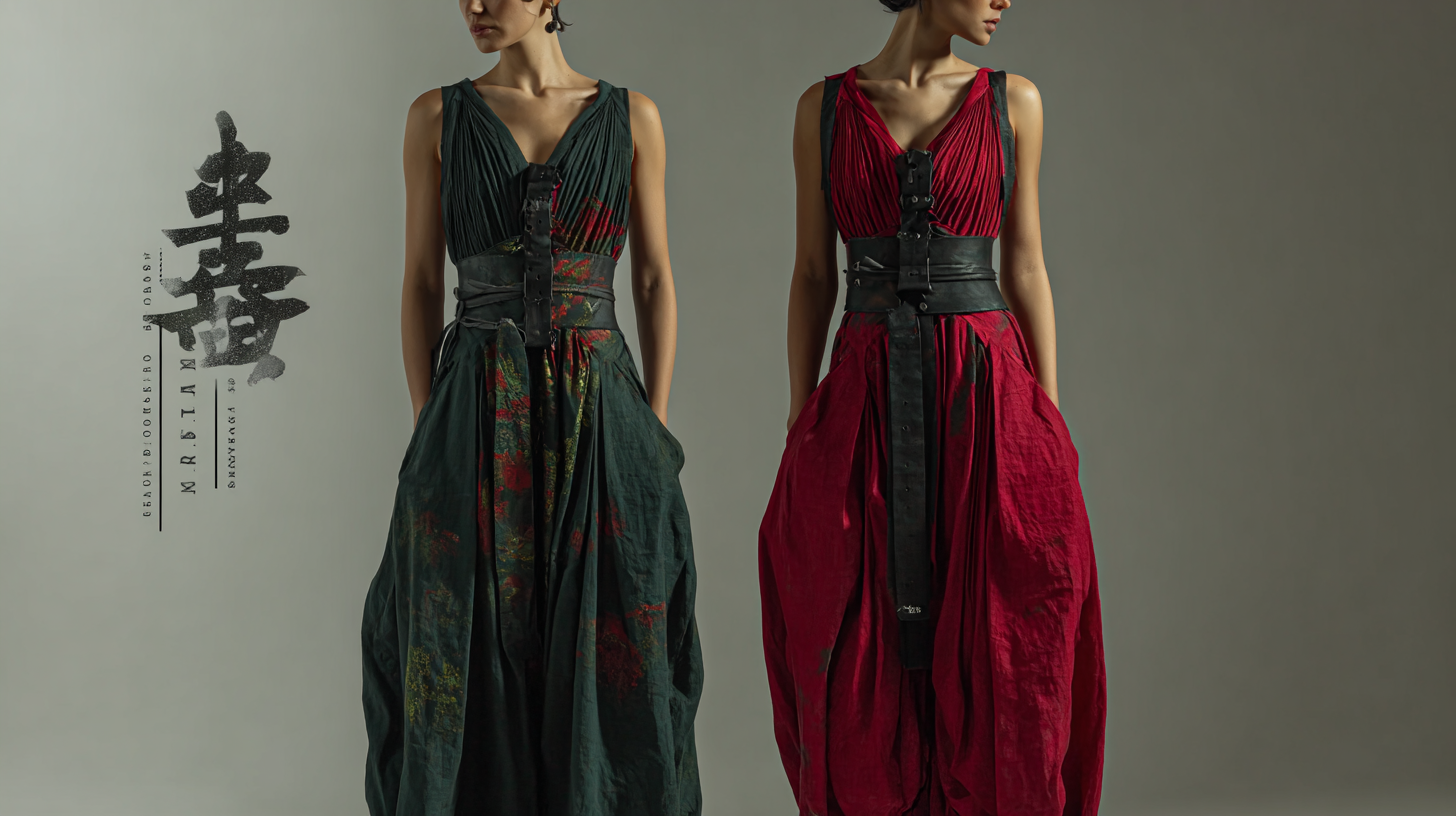Welcome to the TopShow!Garment manufacturing !
OEM, ODM Service,Custom color Custom logo,Custom Your Own Brand Online!
Welcome to the TopShow!Garment manufacturing !
OEM, ODM Service,Custom color Custom logo,Custom Your Own Brand Online!
As the global fashion industry continues to evolve, the demand for high-quality and unique garments remains at the forefront of consumer preferences. The "Strap Pleated Jumpsuit" has emerged as a popular choice, offering a perfect blend of elegance and versatility. According to a recent report by Statista, the global women's apparel market is projected to reach approximately $1.5 trillion by 2025, highlighting a significant shift towards stylish, functional garments that cater to the modern woman.

Chinese craftsmanship plays a vital role in this landscape, renowned for its meticulous attention to detail and innovative design. By merging exquisite Chinese manufacturing techniques with contemporary global fashion trends, the Strap Pleated Jumpsuit exemplifies how traditional and modern aesthetics can coexist, creating pieces that are not only visually stunning but also representative of a thriving international partnership.
In the dynamic world of fashion, the significance of quality suppliers cannot be overstated. As brands strive to align with
corporate social responsibility and sustainability goals, partnering with the right suppliers is crucial. Not only do quality suppliers ensure exceptional craftsmanship, such as that exemplified in exquisite Chinese designs,
but they also play a vital role in minimizing waste and enhancing production efficiency. Techniques like Lean Six Sigma are increasingly being adopted within the industry, demonstrating how systematic approaches can elevate quality and drive sustainable practices.
Moreover, the interaction between supplier performance and brand reputation is becoming more pronounced, especially as consumers demand transparency and accountability. Retailers are utilizing supplier scorecards to assess various factors, including production quality and social impact. This shift towards conscientious sourcing is reshaping the apparel value chain, prompting brands to reevaluate their supplier relationships. As legislation regarding supply chain practices looms on the horizon, the need for robust, sustainable partnerships has never been more critical for the overall integrity and future success of the fashion industry.
When evaluating potential suppliers in garment production, businesses should focus on several key metrics that can significantly influence the overall quality and efficiency of their sourcing strategies. According to a report by McKinsey & Company, 60% of fashion executives believe that collaboration with high-quality suppliers is crucial for remaining competitive in the global marketplace. Consequently, assessing suppliers based on their production capabilities, reliability, and previous experiences can provide significant insights into their potential performance.
Another important metric is the suppliers' adherence to sustainable practices. A survey by Business of Fashion indicates that over 70% of consumers are willing to pay a premium for sustainable products. Therefore, examining a supplier's commitment to sustainable sourcing and manufacturing processes can not only affect brand reputation but also enhance consumer trust and loyalty. Additionally, quality control measures and compliance with international standards should be assessed, as they directly impact the final product's market acceptance and minimize costly returns and reworks.
Lastly, evaluating the financial stability of potential suppliers is critical. According to a report by Statista, 40% of supply chain disruptions are linked to suppliers facing financial difficulties. Thus, companies must conduct thorough due diligence to ensure their suppliers are not only capable of meeting demand but are also sustainable in the long term. By focusing on these metrics, brands can build a robust supply chain that supports exquisite craftsmanship while aligning with global fashion trends.
| Supplier Name | Production Capacity (Units/Month) | Lead Time (Days) | Quality Rating (1-5) | Minimum Order Quantity | Certifications |
|---|---|---|---|---|---|
| Supplier A | 5,000 | 30 | 4 | 100 | ISO 9001 |
| Supplier B | 10,000 | 45 | 5 | 200 | WRAP, GOTS |
| Supplier C | 7,500 | 20 | 3 | 150 | OEKO-TEX |
| Supplier D | 8,000 | 35 | 4 | 300 | ISO 14001 |
| Supplier E | 6,000 | 50 | 5 | 250 | SA8000 |
In the ever-evolving landscape of global fashion, the integration of exquisite Chinese craftsmanship into supply chains offers significant advantages. According to a report by McKinsey & Company, the global apparel market is projected to reach $2.5 trillion by 2025, with a growing emphasis on quality and sustainability. Chinese artisans, renowned for their intricate techniques and attention to detail, are increasingly playing a vital role in elevating the quality of fashion products like the strap pleated jumpsuit. The melding of modern designs with traditional craftsmanship fosters unique creations that resonate with consumers seeking both style and authenticity.
Furthermore, a study by the Business of Fashion highlights that over 60% of fashion brands are actively looking to incorporate sustainable practices into their production processes. As Chinese craftsmanship often emphasizes minimal waste and artisanal methods, it aligns perfectly with this shift. The expert craftsmanship not only ensures superior product quality but also contributes to a more sustainable supply chain. With the implementation of advanced technologies alongside traditional methods, the industry can enhance both efficiency and artistry—creating pieces that reflect a timeless elegance while meeting the demands of modern consumers.
Building long-term relationships with suppliers is crucial for sustaining quality and efficiency in your fashion brand. One effective practice is to maintain open and transparent communication. Regularly discussing your expectations, feedback, and any concerns can help both parties align their goals and reduce misunderstandings. This proactive approach establishes trust, fostering a more collaborative environment.
Another essential tip is to invest in your suppliers. Recognize their contributions and celebrate milestones together. This could mean visiting their facilities, sharing insights about upcoming trends, or even collaborating on special projects. By showing interest in their capabilities and challenges, you create a partnership that emphasizes mutual growth and success.
Lastly, practice flexibility. The fashion industry is ever-evolving, and suppliers may face unforeseen challenges. Being adaptable allows your business to navigate these changes together, strengthening the partnership. When suppliers feel supported and valued, they are more likely to prioritize your brand and deliver exceptional craftsmanship, as seen in exquisite pieces like the strap pleated jumpsuit.

In the rapidly evolving fashion industry, sustainable sourcing has emerged as a cornerstone for future supply partnerships. According to the Global Fashion Agenda's 2021 Fashion Industry Report, over 75% of fashion executives consider sustainability as a key priority. This shift is not merely a trend, but a necessary response to consumer demand; a McKinsey report revealed that 67% of consumers would pay more for sustainable brands. As fashion houses increasingly focus on ethical practices, partnerships with suppliers who prioritize eco-friendly materials and processes are becoming vital for long-term success.

One notable example is the rise of biodegradable fabrics and innovative recycling technologies, which have garnered attention as the industry seeks to reduce its carbon footprint. The Ellen MacArthur Foundation indicates that the fashion industry is responsible for 10% of global carbon emissions, making the transition to sustainability critical. By implementing these sustainable practices, brands not only enhance their marketability but also contribute positively to environmental conservation. As we look to the future, fashion supply partnerships that emphasize transparency, ethics, and eco-friendliness will likely define the next chapter in this vibrant industry.
